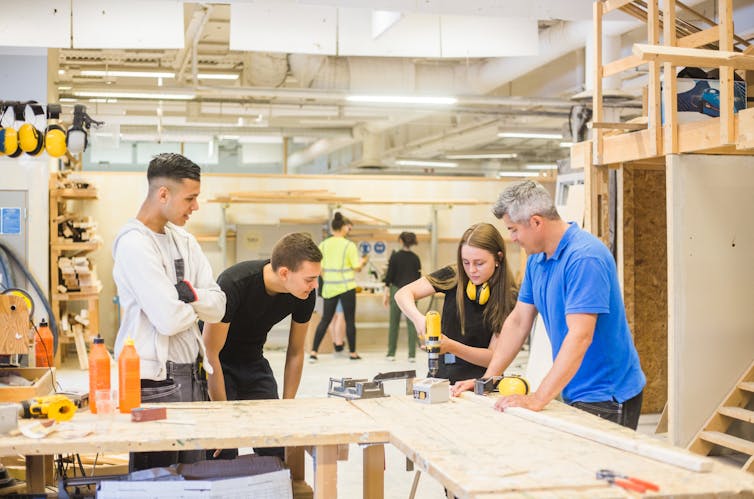
Jay Stratte Plasman, The Ohio State University
The Research Brief is a short take about interesting academic work.
The big idea
Taking a STEM-related career and technical education course in high school makes low-income students more engaged in school than those who don’t take such a course. This is what education scholars Michael Gottfried, Daniel Klasik and I found in our study using survey data from nearly 20,000 high school students across the country.
We found that career and technical education courses related to science, technology, engineering and mathematics were linked with higher engagement in the 11th grade for low-income students. This finding held after taking key student and school characteristics into account, such as student attitudes and academic histories.
By higher engagement, we mean that these students were more likely to show up to school and be prepared for class. They were also less likely to be suspended. Interestingly, we did not find that these courses had the same effect – or any effect at all – for students from middle- or high-income families.
Career and technical education courses in general are designed to be engaging. STEM-related career and technical education courses focus on engineering technology and computer science. These courses teach students applied skills through hands-on experiences. They are meant to prepare students for success in both college and career.
Why it matters
As schools shifted to remote learning during the COVID-19 pandemic, many students became disengaged from school.
Prior to the pandemic, students from low-income backgrounds in particular had lower engagement than students from middle- or high-income backgrounds. During the pandemic, students from low-income backgrounds who were already dealing with issues such as food insecurity, homelessness and access to technology no longer had a physical location to attend school. This led to further disengagement. In Michigan alone, the pandemic resulted in a decrease in enrollment of 53,000 students, many of whom simply stopped going to school. These losses were particularly heavy in urban areas, where low-income families tend to live.
Studies show that students who are more engaged in school have better grades and test scores, better chances of graduating, fewer behavioral problems and are more likely to earn more later in life. STEM-related career and technical education courses are also related to several of these same outcomes.
What still isn’t known
Unfortunately, it isn’t possible to know exactly what goes on in STEM-related career and technical education courses on a large scale. While individual teachers know what they teach and what their students learn, it’s difficult to identify what students are learning or how teachers are teaching different classes in different schools.
Also, we don’t know exactly what might motivate a student to choose a STEM-related career and technical education course over a fine arts or other elective class.
What’s next
Exploring the long-term benefits of STEM-related career and technical education courses is a crucial next step. For example, it will be important to explore whether these courses actually lead to jobs, which we are looking at in some current projects.
Additionally, low-income students are less likely to take STEM-related career and technical education courses than middle- and high-income students. This is unfortunate because STEM careers are both in high demand and provide high wages. Future research will need to explore how to encourage low-income students to take these courses.
Ultimately, career and technical education may provide an interesting opportunity to look at student success as more than just a test score. Rather, it will enable educators to measure success in terms of being ready for a career.
[Get the best of The Conversation’s politics, science or religion articles each week.Sign up today.]![]()
Jay Stratte Plasman, Assistant Professor in Workforce Development and Education at The Ohio State University, The Ohio State University
This article is republished from The Conversation under a Creative Commons license. Read the original article.
The views and opinions expressed in the article are solely those of their authors, and do not necessarily reflect the opinions and beliefs of WomenInScience.com.